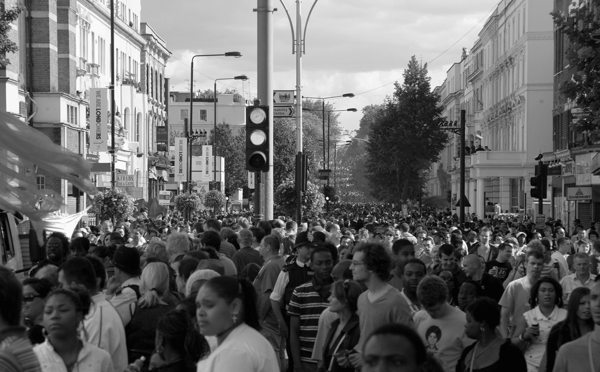


How to Avoid London-Centric Marketing on Paid Social Media




London is amazing, there’s no denying it. However, it needs to be said that the city is not the centre of the universe. So businesses: please stop directing all your paid social media and other marketing efforts only to “London types.” People in Bristol, Birmingham and Manchester all earn money too (and with more reasonable rents, they can actually afford to buy things.) In this blog, we look at the downfalls of London-centric approaches and how you can maximise ROI for paid social media.
As the famous saying goes, “when a man is tired of London he is tired of life.” Nevertheless, there are plenty of men (and women) based outside of the capital. It’s not compulsory to move to Clapham, write blog posts about the dangers of gluten and only eat in “authentic” pop ups.
Too often we speak to clients who want to speak to people aged 30 to 35, who have prestigious jobs, disposable income and upwardly mobile ambitions. You know, the “London types.” My main issues with this approach are the crude assumption that this person only exists in London, and the choice to pigeon hole activity to a very narrow band of people. When we run audience numbers, we often find that while extreme wealth is concentrated in London, there are very large numbers of people outside the M25 who also have money.
London is expensive… No Really
London is expensive, that’s just a fact. With a young and diverse population, it’s great for experiential marketing (i.e. the Carlsberg Beer tap billboard) However, the city does create some patterns that those using paid social media should account for.
One common London lifecycle is for younger graduates and school leavers to go to London, get a decent job and enjoy the city. Once people want to settle down, they often move out of the city to cheaper cities or commutable towns. This can lead to message saturation and income dispersion.
 Message saturation is when too many advertisers focus on a single area, so that consumers become numb to their advertising. Ever been on the northern line from Balham to Kings Cross at 7am? By the time you get off, your seething hatred for humanity prevents you from thinking about buying things. If people don’t respond to your paid social media message, the costs of conversion start to creep up. This is reflected in global advertising cost rankings. Despite all its benefits, London is still ranked ninth in the most expensive European cities to advertise in.
Message saturation is when too many advertisers focus on a single area, so that consumers become numb to their advertising. Ever been on the northern line from Balham to Kings Cross at 7am? By the time you get off, your seething hatred for humanity prevents you from thinking about buying things. If people don’t respond to your paid social media message, the costs of conversion start to creep up. This is reflected in global advertising cost rankings. Despite all its benefits, London is still ranked ninth in the most expensive European cities to advertise in.
The second issue is income dispersal. People start to move out of London, in search of places where a cup of black coffee isn’t £7 and their kids can see grass. The higher income individuals begin to dissipate from the city centre. Now, if you’re trying to sell higher end goods, these are the people you want to reach, not Millenials. In London, Millenials are busy trying to pay rent and making sure their Snapchat story is relevant, not worrying about cars or investments. If you focus on trying to reach highly affluent people in the city centre, you will only get them in work or commuting hours, not when they are at home and probably more receptive to your message.
Don’t worry though. With some simple structured approaches, you can refocus your paid social media campaigns for great ROIs.

Diversity Lowers Costs
London is one of the most diverse cities in Europe, and this diversity gives you more options and variables to use when targeting paid social media campaigns.
The most expensive cities to advertise in are the Nordic regions and Vatican City. This is because they have small to moderate sized populations with high affluence and low diversity. This means that a lot of people want to advertise to them, but can’t diversify their message.
With London, this problem can be negated with clever personas. We love using personas in our paid social media campaigns, as they give great structure and direction. With the right research into your audience, you can find highly engaged individuals in any city.
Look at your product, then the demographics of your chosen city, use our persona method to create highly relevant audiences, and watch your CPCs drop.

The Great Beyond
The North isn’t all 3 eyed crows and white walkers - it’s actually pretty nice when it’s not raining. There’s also a lot of money in up here. In fact, areas such as Tatton in Cheshire rank in the top 10 in the country for median wealth.
A sensible way to structure your paid social media campaign is to build out your personas and then segment by large areas, such as counties. This gives you the ability to adjust budgets for the best ROI, and tailor your ad copy for colloquialisms and local identities.
For one large renewables client, we split the country into eight distinct areas, then took the traits of the “London types” persona and overlaid it in each area. We then looked at specific ad copy and localised the campaigns. What we found was that although London was great for volume, the North West and Midlands actually provided a better return overall. This allowed us to adjust spending levels, and the client made a hefty ROI through paid social media.
London is amazing, but so is the rest of the UK. If you focus entirely on London, you’re stunting the ROI that you could produce elsewhere. Experiment with the whole of the UK, find areas that work for your product.
Lead Generation is a balancing act between Consumers, businesses and a whole host of other stakeholders. But don't panic our blog "Everything you need to know about Lead Generation (and some stuff you don't)" will give you an outline of how you can nail your lead generation.







